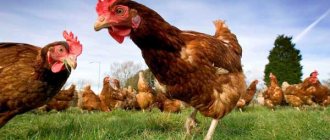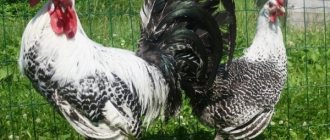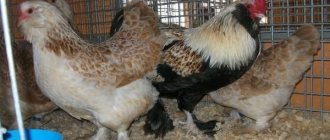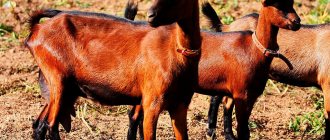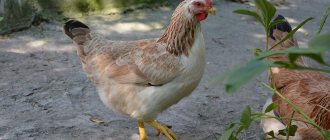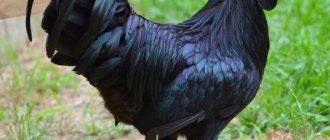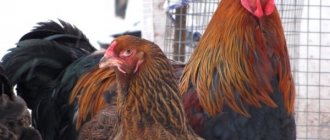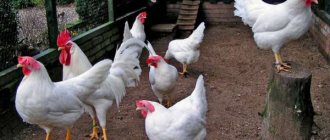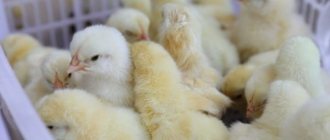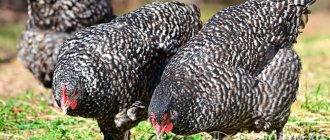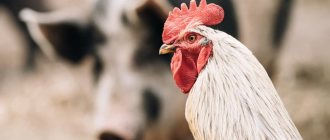Among the mass of different breeds of chickens, a very young, but already positively noted variety, Hercules, stands out. The advantages of the hybrid include fast growth, like broilers, tasty and juicy meat, average egg production and unpretentiousness in nutrition. Chickens lay large eggs and belong to the egg-meat type, which is indispensable in the household.
Hercules chickens
Origin story
Year of creation: 2000. Homeland: Ukraine, Kharkov. The Hercules breed is crosses. Selection work was carried out by scientists under the leadership of Professor Yu.A. Bondarenko. at the Institute of Poultry Science. Work on the creation of these birds lasted about ten years. Hercules combines the gene pool of Ukrainian and foreign birds.
The birds got their name due to their considerable size and high productivity. Although the breed is not even two decades old, it is already famous among poultry farmers.
Laying hen instinct
The Hercules chicken breed is not designed to perform maternal duties. She can be passive throughout the year, but when she suddenly sits on her eggs, she immediately experiences bouts of activity. As a result, the hen does anything other than hatch her offspring.
Due to such an irresponsible attitude towards children, poultry farmers do not recommend letting the hen get involved in this matter; it is better to immediately assign this task to the incubator. Hercules is a breed of chickens with a weak brooding instinct.
Description of the Hercules breed
These poultry have a massive, strong physique and a good character. Let's look at the main characteristics of the breed that are unique to it.
External data
Ukrainian chickens are worthy of admiration. There is nothing exotic or unusual about them, but it is the simplicity in appearance that makes the birds interesting and unique. Hercules looks like a calm village hen; its large build makes the birds clumsy and very cute.
Main characteristics of the breed:
- Weight and dimensions . Since chickens belong to the meat and egg group, the mass of birds is impressive. Females weigh approximately 3.5 kg, and roosters can reach 4.5 kg. These indicators characterize birds on average; with proper quality care, the mass of birds can reach higher indicators. Hercules roosters weighing 9 kg have been captured in nature, and such cases are becoming more and more common.
- Ukrainian beauty can be in several colors : cuckoo, golden, pockmarked, silver, white. According to poultry farmers, golden quolls have the highest egg production, but white ones are the largest.
- The body is trapezoidal, well defined, with a wide back, large chest and a rather large tummy. Both females and males are identical in physique, differing only in size.
- The head is small. Although in fact she is quite large, she just seems miniature against the background of her whole body. Feathers do not grow on the skin of the face. The crest is developed, and in some roosters it hangs slightly to one side. Ears are small in size.
- The plumage consists of closely spaced dense feathers. There is a huge amount of fluff underneath. They are striking in the size of the braids on the tail, especially in roosters.
Character
In appearance, Ukrainian hens frighten people, they seem formidable and lively, but in fact this is a delusion. The hens are very calm, peaceful and kind. They know how to negotiate with other birds, they do not offend their family members, they always give in.
Representatives of the breed lead a calm lifestyle and treat all adversities and problems in the yard with indifference and without interest. Birds are not afraid of people, they do not experience stress, and they are not shy.
Productivity
The name Hercules speaks for itself. The birds are famous for their high productivity (about 200 eggs per year) and a large amount of meat per chicken.
Puberty and egg production
Hercules bird eggs are popular not only with industrial farmers, but also with their farm owners. Quotes are bred not only in your own yard, but also on an industrial scale - in poultry farms.
The first eggs can be obtained when hens are approximately 5 months old. In some cases, puberty occurs at 6 months. The main task of the poultry farmer is to provide the laying hens with good and high-quality nutrition, then laying will begin faster and no problems will arise with the eggs or the birds.
Egg production from 1 hen per year reaches 200 pieces, all eggs are large - from 60 to 70 g.
A special feature of Hercules laying eggs is that the yolk is large and takes up almost 40% of the total product. The shell is light.
Maternal instinct
The brooding instinct is completely absent, and this is not surprising, because almost all hybrids and crosses have lost this characteristic. The Hercules chicken breed was no exception. Laying hens behave calmly and passively throughout the year, but as soon as they sit on their offspring, their behavior immediately changes: the hens become aggressive and active. As a result, the hen does everything she can, except hatching the babies.
Such careless attitude towards young animals forces poultry farmers to use an incubator or other breeds for hatching eggs that have this instinct.
Nutritional features of adult chickens
Summer and winter options
The basis of the diet of laying hens in the summer is:
- whole grains: corn, oats, barley, wheat – 98 g;
- wheat bran – 10 g;
- protein-containing feed: fish, meat and bone, clover, alfalfa meal, cake, skim milk – 35 g;
- green herbs: alfalfa, nettle, clover, carrot tops, beets, cabbage leaves - 60 g.
In winter, the diet is supplemented with boiled potatoes, chopped root vegetables (carrots, pumpkin) - 80-100 g.
The lack of green feed is made up for with hay flour from legumes, silage, grass or pine flour - 40 g.
They also increase the content of dairy products: yogurt, skim milk, low-fat cottage cheese - up to 100 g.
A description of the daily menu for one adult laying hen is given.
How to feed and drink properly
To feed Hercules chickens, dry, wet and combined feeding methods are used.
The most common is combination feeding. Chickens receive dry food and wet mash 2-3 times a day.
An important requirement when feeding wet food. Chickens should eat it within 2-3 hours. Especially in summer. Otherwise, the food may spoil, which will lead to poisoning of the bird.
For the functioning of metabolic processes, chickens need unlimited access to water. Its consumption rates: up to 300 ml per day per bird.
Help for laying hens
During the period of egg production, chickens lose most of their microelements, so normal laying requires replenishment of minerals. Shells, crushed bones, egg shells, chalk (no more than 5% of the total volume) are added to the diet.
Also, to improve egg production, BVMD or premixes for laying hens are suitable.
To grind feed in the chicken's stomach, containers with gravel and sand are placed next to the feed tray. For chickens, fine-grained gravel with a diameter of 1-2 mm is used, for adult birds - with a diameter of 5-6 mm.
Care and maintenance
Feathered Hercules do not require special care; they tolerate natural changes without problems and quickly adapt to them.
Poultry house
Due to the fact that the birds are very massive, they need to build a large-area poultry house. Birds should feel comfortable in it, do not place many individuals in one area: stick to a small number of birds or build another chicken coop.
Read the article on how to make a chicken coop yourself.
The large mass of Hercules forces the farmer to make changes in the arrangement of the chicken coop - roosts are not installed in it. Birds simply will not be able to climb into them. Therefore, great attention should be paid to the flooring, because this is where the chickens will spend most of their time. It is better to lay a layer of straw, hay or peat on the floor. It is constantly monitored and changed from time to time.
Temperature, humidity and lighting
For a long time, residents of the northern regions could not get enough of these crosses. Finally, breeders have created laying hens suitable for living in cold areas. Choughs of the Hercules breed can easily tolerate being kept in a chicken coop in winter without special heating devices, and in cold weather the birds can walk outside.
Birds are happy to be active in the snow; this activity makes their immunity even stronger. And the moment when the cows go outside is considered a good time to ventilate the room.
Exception: the air temperature is below -20 degrees Celsius - chickens cannot be taken outside.
As for lighting, its indicator varies depending on the age of the birds. For example, babies need 40 lux, over time the brightness is reduced, and adult chickens live in a light of 7 lux. If a rooster lives in the same room with the laying hens, then the lighting indicator is slightly increased.
Maintain optimal humidity in the chicken coop (about 50%). It increases due to wet bedding, water and mash. Ventilate the room regularly and remove all unnecessary moisture.
Walking yard
The Hercules breed of chickens is not capable of living only in a chicken coop; it needs fresh air and frequent walks. You can't do without a walking yard. It should be spacious so that the birds do not push each other, can go about their business and do not get nervous due to discomfort.
In the summer and spring seasons of the year, birds love to feast on various green herbs; for this, poultry farmers plant nettles or clover in the walking yard. Birds happily eat them. You can also plant cereal crops.
The chicken coop and its courtyard should be built on a small hill, otherwise runoff water will begin to flood the area.
Feeding
In order for birds to grow not only healthy and big, they need to be fed efficiently and faithfully. The key to a good appetite in chickens is fresh air, clean water and disease prevention. Any breed needs containers with pebbles, chalk and shells.
At different times of the year, depending on the age of the chickens, the menu changes and is supplemented. The main thing is that the dishes are complete and balanced. The growing period for Hercules lasts about 12 months, so the basis in the 1st year is protein grain feed. Root vegetables, fruits and vegetables are used as an additional component. Green herbs occupy a special place; they can be given both fresh and dried.
The following products serve as additional minerals:
- worms and insects;
- salt;
- flaxseed (approximately 0.01 kg per 1 hen);
- meat and bone meal.
Molting and break in egg production
Chickens that lose their old feathers seem very pitiful and unhappy, but in fact this phenomenon does not cause them much inconvenience. Hercules cope with this process steadfastly and recover quickly. Birds have a huge number of feathers, but literally in 60-70 days they appear anew. During this period, the main thing is to add fats of animal origin to food, for example, fish oil and broths.
Some birds do not want to molt, in these cases it is necessary to use non-standard methods for inducing molt, but often poultry farmers do without them.
The danger is the risk of cannibalism. In these cases, individuals eat birds of their own breed. To avoid this, you need to feed the birds correctly and often.
Planned herd replacement
Poultry of the Hercules breed are kept in the yard for about 2 years, then the stock is renewed. Older birds are no longer distinguished by high egg production and the presence of tender and juicy meat.
Breeding
Chickens of this breed were obtained by crossing 4 species of birds, so breeding Hercules at home will not lead to anything good. When crossing crosses or hybrids, the offspring lose their genetic characteristics.
The main characteristics can be preserved only in the 1st generation; then all genetic characteristics are not preserved. After this, purebred chickens completely degenerate.
When breeding birds from eggs, only 25% of the breed characteristics are preserved. To obtain purebred babies, experienced farmers buy hatching eggs from special poultry farms.
If all requirements for breeding young animals are met, the hatchability of chickens in the incubator is about 85%. Babies are born very small, but then rapidly gain weight.
You can read about the features of incubating chicken eggs in this article.
Raising chickens
Beginning farmers have a hard time raising chickens because they are tiny and sensitive. The smallest mistakes lead to irreparable consequences. To avoid the loss of young animals, you must immediately study all the useful information and unquestioningly follow the rules for raising chickens.
The young animals lack a comb; it appears over time. The shade of the fuzz is different, it all depends on the color of the parents. The chicks are born very small, then the weight increases, and the crumbs reach 1.8 kg in 2 months.
Caring for chickens is simple, you need to hold out for 3 weeks until they are very tiny and defenseless. At this time, babies need to maintain a constant temperature, frequent meals and prevent diseases.
When breeding young animals, approximately 10% of the generation of the total number of eggs is not preserved.
Recommendations for caring for Hercules babies:
- For the first 3 days after birth, illuminate the house with special lamps without interruption.
- The air temperature should be approximately +32 degrees Celsius. Reduce the rate every week. When the babies reach 1 month, they do not need additional heating; at this point, transfer the chicks to adult birds.
- The chicks' food must be of high quality and plentiful. In order for birds to grow and develop quickly, the menu should be dominated by foods with protein and calcium. Minerals and vitamins are especially important.
- Monitor the availability of fresh and clean water, without it the young animals will die.
Incubation
To produce offspring, hens are crossed with Cornish roosters. For incubation, eggs weighing about 70 grams are chosen - smaller ones produce defective offspring. Incubation temperature is from 38.3 to 37.2 o depending on the incubation day. The eggs are selected to be the same size, without cracks or chips.
Table of temperature and humidity modes
| Period |
